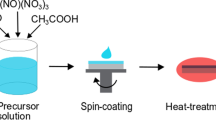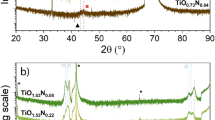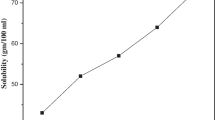Abstract
This work studies the mechanism of laser-induced decomposition of nickel(II) chelate complexes with dimethylglyoxime Ni(DMG)2 and with a dehydrogenated free-radical methyl derivative of 1,2-hydroxylaminooxime, Ni(HAO)2, as solid films and powders. Stable gaseous products of the laser-induced decomposition of these complexes are compared with those of thermal decomposition; the comparison shows that the products considerably differ. Experiments revealed a markedly threshold character of the dependence of the degree of conversion on XeCl excimer laser irradiance. These two facts, along with mass-spectrometry data for chelates subjected to ionization by positive and negative ions, suggest a two-photon photochemical mechanism of the decomposition. In the condensed state the photoionization of a chelate molecule is accompanied by transfer of an electron to the lattice with further localization of the electron on the antibonding orbital of the neighboring molecule, which results in fragmentation of the latter. The secondary decomposition processes depend on the electronic and stereochemical structure of the complexes. When irradiated by XeCl excimer laser in air, thin layers of the chelates on Si and SiO2 substrates undergo explosive decomposition. The gaseous products of this reaction are ejected into the atmosphere, and the surface of the substrate is covered by a thin dielectric film, whose refractive index is close to that of nickel hydroxide.
Similar content being viewed by others
References
T. Ushida, K. Higashiyama, I. Hirabayashi, and S. Tanaka,Jpn. J. Appl. Phys.,30, No. 1A, L35-L38 (1991).
B. G. Anex and E. K. Krist,J. Am. Chem. Soc.,89, No. 24, 6114–6125 (1967).
S. V. Larionov, V. N. Kirichenko, A. I. Stetsenko, et al.,Zh. Neorg. Khim,28,28, 411–416 (1983).
E. O. Schlemper and R. K. Murmann,Inorg. Chem.,22, No. 7, 1077–1081 (1983).
T. V. Troepolskaya, G. A. Vagina, V. I. Morozov, et al.,Izv. Akad. Nauk SSSR, Ser. Khim., No. 23, 553–558 (1987).
S. V. Larionov and L. A. Kosareva,Zh. Neorg. Khim.,31, No. 9, 2334–2338 (1986).
J. L. Garnett, I. K. Gregor, M. Guilhaus, and D. R. Dakternieks,Inorg. Chim. Acta,44, No. 3, L121-L124 (1980).
B. Marciniak and G. E. Buono-Core,J. Photochem. Photobiol. A: Chem.,51, 1–25, (1990).
N. Mikami, R. Ohki, and H. Kido,Chem. Phys.,141 431–440 (1990).
F. A. Cotton and J. J. Wise,Inorg. Chem.,6, No. 5, 917–924 (1967).
V. F. Plyusnin, E. P. Kuznetsova, I. V. Khmelinskii, et al.,J. Photochem. Photobiol. A: Chem.,63, 289–301 (1992).
Gmelins Handbuch der Anorganischen Chemie. System-Nummer 57, Nickel, Teil C, Lfg. 2, Verlag Chemie, Weinheim (1969), pp. 844–853.
C. V. Banks and D. W. Barnum,J. Am. Chem. Soc.,80, No. 18, 4767–4772 (1958).
R. H. Pierson, A. N. Fletcher, and E. St. Clair Gantz,Anal. Chem.,28, No. 8, 1218–1239 (1956).
N. Nakamoto,Infrared Spectra of Inorganic and Coordination Compounds, Wiley, New York (1963).
K. Nakanishi,Infrared Absorption Spectroscopy. Practical, Holden-Day, San Francisco (1962).
I. B. Bersuker,Jahn-Teller Effect and Vibronic Interactions in Modem Chemistry [in Russian], Nauka, Moscow (1987).
K. M. Indrichan, N. V. Gerbeleu, and S. V. Larionov,Izv. Akad. Nauk SSSR, Ser. Khim., No. 1, 53–55 (1989).
F. A. Cotton and J. J. Wise,Inorg. Chem.,5, No. 7, 1200–1207 (1966).
D. G. Batyr, F. A. Spatar', and S. S. Budnikov,Koordinats. Khim. 9, No. 11, 1452–1457 (1983).
S. M. Schildcrout and L. M. Besozzi,Inorg. Chem.,29, No. 5, 1054–1057 (1990).
J. Charalambous, J. S. Morgan, L. Operti, et al.,Inorg. Chim. Acta,144, No. 2, 201–203 (1988).
P. L. Beaumont, J. L. Garnett, and I. K. Gregor,ibid.,45, No. 3, L99-L101 (1980).
H. F. Holtzelaw, R. I. Lintvedt, H. E. Baumgarten, et al.,J. Am. Chem. Soc.,91, No. 14, 3774–3778 (1969).
J. B. Westmore and D. K. C. Fung,Inorg. Chem.,22, 902–907 (1983).
J. L. Wood and M. M. Jones,J. Phys. Chem.,67, No. 5, 1049–1051 (1963).
Additional information
This work was presented at SPIE's International OE/LASE'94.
Institute of Inorganic Chemistry, Siberian Branch, Russian Academy of Sciences. Translated fromZhurnal Strukturmoi Khimii, Vol. 35, No. 1, pp. 70–80, January–February, 1995.
Rights and permissions
About this article
Cite this article
Badalyan, A.M., Polyakov, O.V., Prokhorova, S.A. et al. UV laser-induced decomposition of nickel(II) dimethylglyoximate and dehydrogenated 1,2-hydroxylaminooximate in thin films. J Struct Chem 36, 60–68 (1995). https://doi.org/10.1007/BF02577750
Received:
Issue Date:
DOI: https://doi.org/10.1007/BF02577750




